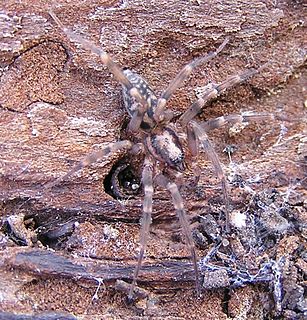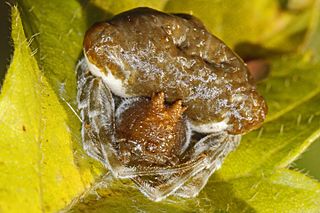
Liocranidae is a family of araneomorph spiders first described by Eugène Simon in 1897. They are one of several groups called "sac spiders". The holarctic genus Agroeca is the best-known, but it also includes various genera of more obscure spiders that still lack a diagnosis. Two species in the North American genus Neoanagraphis are found in the extremely dry conditions in the Mojave, Sonoran and Chihuahuan deserts. Females live in animal burrows while males wander and are the ones most often caught in pitfall traps.

Ralph Vary Chamberlin was an American biologist, ethnographer, and historian from Salt Lake City, Utah. He was a faculty member of the University of Utah for over 25 years, where he helped establish the School of Medicine and served as its first dean, and later became head of the zoology department. He also taught at Brigham Young University and the University of Pennsylvania, and worked for over a decade at the Museum of Comparative Zoology at Harvard University, where he described species from around the world.
Lygromma is a spider genus of Central and South America. There are species with eight, six and no eyes. The eyeless L. anops is endemic to Galapagos, while the not closely related blind L. gertschi is found only on Jamaica.

Joseph Conrad Chamberlin was an American arachnologist who studied mainly pseudoscorpions. A native of Utah, he studied primarily at Stanford University while working most of his career in Oregon for the U.S. Department of Agriculture. Several species are named in his honor.
Mallos is a genus of cribellate araneomorph spiders in the family Dictynidae, and was first described by O. Pickard-Cambridge in 1902. Among the genus, Mallos gregalis is known to be a social spider species, living in groups and signaling each other by vibrating their web.
Aphonopelma chamberlini, also known as the Paso Robles rusty red tarantula, is regarded by some sources as a tarantula species endemic to California, and by others as synonymous with Aphonopelma iodius.

Neoanagraphis is a genus of spiders in the family Liocranidae. It was first described in 1936 by Gertsch and Mulaik. As of 2016, it contains two species: N. chamberlini and N. pearcei.
Clubiona kastoni, the kaston sac spider, is a species of sac spider in the family Clubionidae. It is found in the United States and Canada.
Tibellus chamberlini is a species of running crab spider in the family Philodromidae. It is found in the United States and Canada.

Trachelas tranquillus, the broad-faced sac spider, is a species of true spider in the family Trachelidae. It is found in the United States and Canada.
Diguetia albolineata is a species of desertshrub spider in the family Diguetidae. It is found in the United States and Mexico.

Acanthepeira stellata, known generally as the starbellied orbweaver or starbellied spider, is a species of orb weaver in the spider family Araneidae. It is found in a range from Canada to Mexico.It is most commonly found along the Eastern and Western coastline of North America.
Herpyllus cockerelli is a species of ground spider in the family Gnaphosidae. It is found in the United States and Mexico.

Philodromus marxi, the metallic crab spider, is a species of running crab spider in the family Philodromidae. It is found in the United States.

Mastophora phrynosoma is a species of orb weaver in the spider family Araneidae. It is found in the United States. Like all known species of the genus Mastophora, adult females are bolas spiders, capturing their prey with one or more sticky drops at the end of a single line of silk rather than in a web. Males and juvenile females capture their prey directly with their legs.

Phrurotimpus is a genus of araneomorph spiders first described by R. V. Chamberlin and Wilton Ivie in 1935. Originally added to the Liocranidae, it was moved to the Corinnidae in 2002, then to the Phrurolithidae in 2014. They have red egg sacs that look like flattened discs, often found on the underside of stones.
Pocadicnemis pumila is a species of dwarf spider in the family Linyphiidae. It is found in North America, Europe, Turkey, Caucasus, a range from Russia, and Japan.

Scytodes fusca, the brown spitting spider, is a species of spitting spider in the family Scytodidae. It is found in Central and Southern America, has been introduced into Europe, tropical Africa, Seychelles, Myanmar, China, Japan, and Hawaii.
Allocosa chamberlini is a species of wolf spider in the family Lycosidae. It is found in the United States.
Phidippus comatus is a species of jumping spider in the family Salticidae. It is found in North America.










